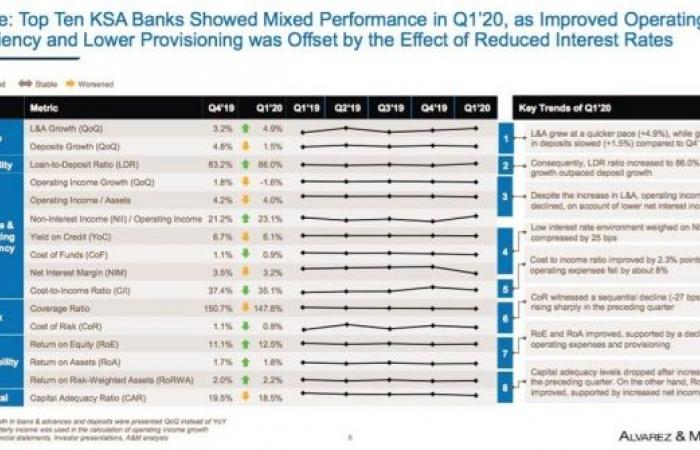We show you our most important and recent visitors news details Saudi banks’ profitability witnessed improvement in Q1 2020 in the following article
Hind Al Soulia - Riyadh - RIYADH – Leading global professional services firm Alvarez & Marsal (A&M) released its first ever edition of the KSA Banking Pulse. The report reveals that the top banks in Saudi Arabia showed mixed performance in Q1 2020 as improved operating efficiency and lower provisioning was offset by the effect of reduced interest rates.
Despite the outbreak of COVID 19, the performance of KSA banks in terms of L&A growth has been encouraging as it grew by +4.9% QoQ in Q1’20. Profitability has also improved with RoE increasing to 12.5% in the first quarter of the year, as increased operating efficiency and lower provisioning helped in negating the effect of lower operating income.
Total operating income fell 1.6% QoQ, as net interest income (NII) decreased 3.9% QoQ. Following the Q1’20 results major banks have also reduced their FY’20 guidance acknowledging the tough market conditions.
Alvarez & Marsal’s KSA Banking Pulse examines the data of the 10 largest listed banks in the KSA, comparing the first quarter of 2020 (Q1 2020) against the previous quarter (Q4 2019).
The prevailing trends identified for Q1 2020 are as follows:
1. Loans & advances (L&A) and deposits of the top ten banks in Saudi Arabia increased even with tough macroeconomic conditions. Despite the lockdown measures announced towards the end of Q1’20, L&A and deposits increased 4.9% QoQ and 1.5% QoQ, respectively. L&A growth was higher compared to the preceding quarter (3.2%), however, deposit growth was relatively lower (4.8%). Consequently, net loans to deposit ratio increased to 86.0% from 83.2%.
2. Decline in net interest income weighed on operating income. Total operating income fell 1.6% QoQ, as net interest income (NII) decreased 3.9% QoQ. NII dropped as low interest rates more than offset an increase in L&A. However, this was partially offset by an increase in non-interest income, which grew by 7%. Non-interest income increased as certain banks reported strong trading income during the quarter.
3. Low interest rates weighed on NIM. Aggregate NIM fell by 25 bps to 3.20% in Q1’20, largely on account of a 59 bps decline in yield on credit. NIM were at multi-period low levels in Q1’20, with almost all banks reporting decline in their NIM.
4. Cost-to-income ratio improved after rising in the previous quarter. Cost-to-income (C/I) ratio fell to 35.1% in Q1’20, compared to 37.4% in Q4’19. Total operating expenses for the coverage banks dropped 7.7%, on the back of cost efficiency measures. Six of the ten banks reported a decline in their C/I ratio.
5. Provisioning decreased on a sequential basis, but increased substantially annually. Total provisioning fell by 21.8% QoQ. However, NPL / net loans ratio increased from 1.8% in Q4’19 to 1.9% in Q1’20. Cost of risk decreased from 1.09% in Q4’19 to 0.82% in Q1’20. However, coverage ratio declined for the fourth consecutive quarter to reach 147.8%.
6. Profitability improved as cost efficiency measures and reduced provisioning helped in offsetting the effect of reduced interest rates Net income increased 13.1% QoQ, as decline in operating expenses and provisioning more than offset a drop in total operating income. Consequently, RoE increased from 11.1% in Q4’19 to 12.5% in Q1’20.
Alvarez & Marsal’s report uses independently sourced published market data and 16 different metrics to assess banks’ key performance areas, including size, liquidity, income, operating efficiency, risk, profitability and capital.
The country’s 10 largest listed banks analyzed in A&M’s KSA Banking Pulse are National Commercial Bank (NCB), Al Rajhi Bank, Riyad Bank, Samba Financial Group, Saudi British Bank, Banque Saudi Fransi, Arab National Bank, Alinma Bank, Saudi Investment Bank and Bank Al Jazira.
Dr. Saeeda Jaffar, A&M managing director and head of Middle East said, “We are delighted to launch the first edition of the KSA banking pulse report; this comes at an especially important time as the banking sector, and wider business community, look to better understand the effects of COVID-19 on the performance of the Kingdom’s biggest banks. We have seen that profitability of the top KSA banks in Q1’20 showed substantial improvement.”
Asad Ahmed, A&M managing director, said, “The sector is likely to face a challenging environment due to COVID 19 headwinds. With oil prices dropping, austerity measures from the government are likely to delay major projects and impact demand in the economy. Thus, we expect loan growth to remain limited, while low interest rate regime coupled with a possible increase in provisioning will impact profitability. In the medium to long term, banks are likely to focus more on rationalizing their costs to hedge against the uncertain conditions” — SG
These were the details of the news Saudi banks’ profitability witnessed improvement in Q1 2020 for this day. We hope that we have succeeded by giving you the full details and information. To follow all our news, you can subscribe to the alerts system or to one of our different systems to provide you with all that is new.
It is also worth noting that the original news has been published and is available at Saudi Gazette and the editorial team at AlKhaleej Today has confirmed it and it has been modified, and it may have been completely transferred or quoted from it and you can read and follow this news from its main source.

